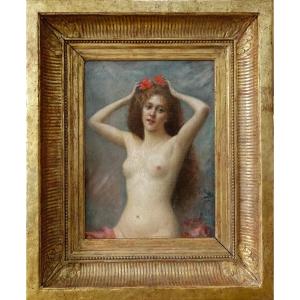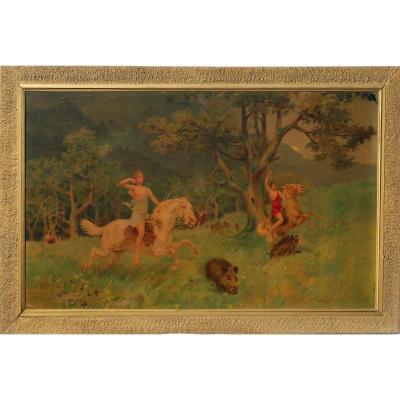Exceptional oil on canvas representing: "Thetis asks Vulcan for the weapons for Achilles" around 1700
Oil on canvas, framed in a Louis XIV period carved and gilded oak frame
Dimensions without frame: Height; 103.5cm Width: 150.5cm
Dimensions with frame: Height; 133cm Width; 181cm
We enclose a certificate issued by the Cabinet Turquin.
Provenance:
- Probably John Prestage (+ 1767) auction, London, February 2-4, 1764, along with other masterpieces of Italian painting from Venetian collections, including that of the Grassi family, and imported to England.
- Lady Edward Elias Sassoon Collection (née Leontine Levy, 1861-1955); Leontine Levy, born in Cairo, married Edward Elias Sassoon (1853-1924), the second baronet of Bombay, who belonged to the Sassoon dynasty, called the "Rothschilds of the East" for their wealth. In her house at 19 Belgrave Square, she assembled a collection of paintings by old masters and English and French furniture and art objects (11). Her collection passed to her heirs, including her daughter:
- Lady Arthur Erskine Humphreys-Owen (née Isabelle Rosalind Sassoon, 1885-1965); and her daughter.
- Miss Elizabeth Humphreys-Owen.
- Auction Sotheby & Co. London, November 16, 1966:
66. A. BALESTRA Thetis and Achilles at the forge of Vulcan; 40 in. by 59 in.
- New York, Central Pictures Galleries.
- O. Klein Collection, New York
- Acquired by the J. Paul Getty Museum, Los Angeles, 1969, (inv. A69.P.24).
- Bob Reynolds Jones Jr. Collection After a painting exchange with the Getty Museum.
The episode depicted tells of the nereid Thetis who goes to the forge of Vulcan to ask him to create weapons for her son Achilles .
It is the tenth year of the Trojan War. In the Greek camp, a quarrel broke out between Agamemnon, the leader of the expedition, and Achilles, the strongest of the warriors. Achilles withdraws from the battle and his closest and most loyal friend, Patroclus, asks him to borrow his weapons to terrorize the Trojans in battle. Patroclus, however, is defeated and succumbs to the strength of Hector, the son of the Trojan ruler, Priam, and the most talented warrior of the Trojans. Hector strips the corpse of its weapons. Achilles, overwhelmed by grief and eager for revenge, needs new weapons to return to battle and challenge Hector.
His mother Thétis, hearing his cry of pain from the bottom of the sea (3), comes out of the waters, meets her son and promises him new weapons. She then goes up to Olympus in the forge of Vulcan and asks the god, whom she had saved some time ago, to forge new weapons for Achilles. The god made them and at the dawn of the new day Thetis gave them to her son.
Born in Verona on August 12, 1666 to a wealthy merchant family, he began his studies for a literary career at the Jesuit College of his native city, where he could familiarize himself with mythological and scholarly subjects; he thus laid the foundations for his interest in books, which would accompany him throughout his life. At the same time, he devoted himself to painting as an amateur and attended the school of the mediocre painter Giovanni Zeffis.
He had to abandon it after the death of his father, when he had to take care, with his brothers, of the mercatura activities of the family.
Nevertheless, a few years later, authorized by his mother and brothers, he devoted himself exclusively to painting. Between 1687 and 1690 he was in Venice at the school of the painter Antonio Bellucci, who, inspired by the Bolognese and Roman models, became one of the protagonists of the academic trend in the lagoon city.
In 1691, Antonio Balestra moved to Rome and joined the school of Carlo Maratta, a powerful and recognized leader of the classical school; in the Eternal City, he also studied ancient art and the works of great masters: Raphael, Carracci, Reni, Dominiquin. In Rome he also attended the Academy of San Luca (of which he was recognized as a member in 1725), where he won first prize in 1694 with a drawing of The Fall of the Giants. In the same city, together with his friends Benedetto Luti and Tommaso Redi, both Florentines, Balestra established in the palace of the Field of Mars of Grand Duke Cosimo III de' Medici an "Academy of Nudes free of charge, at their own expense", attended by many young painters and sculptors. In the same period he went to Naples to discover the work of Mattia Preti, Luca Giordano and Francesco Solimena. In 1695 he left Rome and, after a brief stopover in Bologna, went to Verona and then to Venice. In 1700, another study trip took him back to Bologna and then to Modena, Parma, Piacenza and Milan. He then returned to Venice and remained there until 1718. In 1719 Antonio Balestra was finally back in Verona, where he filled his school, which allowed him to fulfill the orders he received from all over Europe. Among his pupils, the painter Giambettino Cignaroli and the famous portraitist Pietro Rotari.
In Verona Antonio Balestra died a few years later, on April 21, 1740






























 Le Magazine de PROANTIC
Le Magazine de PROANTIC TRÉSORS Magazine
TRÉSORS Magazine Rivista Artiquariato
Rivista Artiquariato
